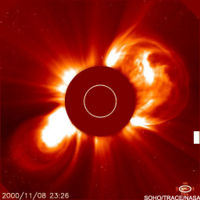Coronal Mass Ejections
Coronal Mass Ejections (CMEs) are a direct result of magnetic instabilities (i.e. solar flares) on the surface of the Sun erupting and expelling millions of tons of solar plasma into interplanetary space. CMEs are strongly influenced by the interplanetary magnetic field (IMF).
Has anyone bsdeies Ron Paul ever really pushed the gold standard idea? I know from reading one of Paul's books that some members of Congress actually think we are still on the gold standard. Also, everything is relative. Sure if you are looking at the two situations (US and Europe) the one in Europe is more of a crisis in the sense that the US has more tools to deal with the situation. However, for people in the states the debt crisis is not contrived and is of a real and immediate concern. Calling it contrived doesn't actually make it so.
Detecting damaging CME ions
Warning Mars settlers about the onset of damaging ions is therefore a high priority. Even on Earth, predicting CMEs and dangerous ions is very important as a massive current of global scale is applied during solar storms. This effect can damage delicate satellite circuits, thermally expand the upper atmosphere (thickening the atmosphere in low Earth orbit, slowing down satellites and decreasing their orbital altitudes) and even cause damage to power grids on the ground (auroral electrojets can have the effect of overloading country-wide electricity grids).[1] Methods of predicting and detecting Coronal Mass Ejections are constantly being developed, but the most effective way of detecting the onset of an Earth-bound CME is to have a probe between the Earth and Sun.[2]
A contingency for Mars
Currently, Mars has no probe or observatory in the line of sight (LOS) of the Sun, leaving an unpatrolled expanse of interplanetary space for dangerous solar ions to pass unchecked. A possible solution (akin to the Earth's SoHO[3] or ACE[4] observatories) could be to establish a simple and inexpensive solar observatory at the first Lagrangian Point[5] (L1) in the Mars-Sun system. This is a gravitationally stable point in direct LOS with the Sun where a probe can be inserted to orbit around the Sun at the same rate as Mars. This proposed system would provide some warning for Mars settlers of the propagation of solar ions toward the Red Planet. See also: Early warning system
References
| Concepts: | Greenhouse · Settlements · Locations · General |
| Hazards: | Space Weather · Climate · General |
| Technology: | Hi-Tech · Lo-Tech · Energy · Spaceflight science · Communication · General |
| Human Considerations: | Economics · Health · Governance · Trade · Law · Social |







